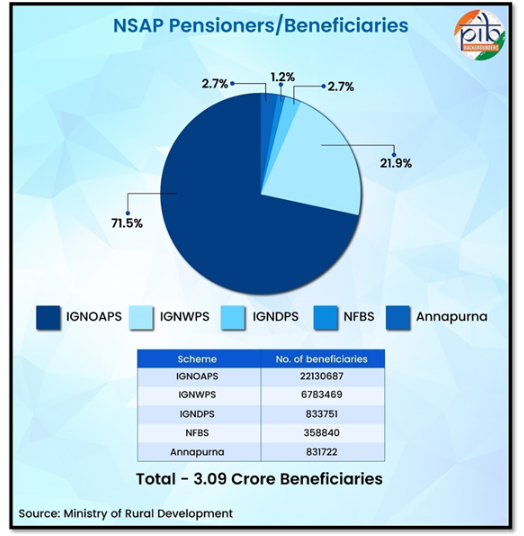“Strengthening India’s Social Security Framework through Inclusive Assistance”
Introduction:
The National Social Assistance Programme (NSAP), launched on 15 August 1995, represents India’s commitment to building a rights-based social security framework for the poorest and most vulnerable. Implemented by the Ministry of Rural Development. The programme is a fully funded centrally sponsored scheme, covering both rural and urban areas.
Objectives of NSAP
-
- To provide basic social security and income support to vulnerable individuals and families living below the poverty line.
- To ensure minimal financial protection for elderly persons, widows, persons with disabilities, and families who lose their primary breadwinner.
- To promote inclusive growth and ensure that nobody is left behind in accessing social protection.
- NSAP operationalises the spirit of the Directive Principles of State Policy (Article 41, 42, 47) by providing social assistance to the old, widows, persons with disabilities, and bereaved households.
At present, NSAP supports 3.09 crore beneficiaries. This makes NSAP one of the largest social security interventions in the world, targeting the poor and vulnerable.

Five Sub-Schemes under NSAP are:
1. Indira Gandhi National Old Age Pension Scheme (IGNOAPS)-
-
-
-
- The Indira Gandhi National Old Age Pension Scheme extends financial assistance to elderly citizens aged 60 years and above who belong to families living below the poverty line by the Government of India.
- Under this scheme, individuals between 60 and 79 years of age receive Rs.200 per month from the Central Government, while those aged 80 years and above are provided Rs.500 per month.
- Currently, the top-up provided by States and UTs under the old age pension component ranges from Rs.50 to Rs. 5700 per month, leading to an average pension of around Rs.1100 in many of the States/UTs.
-
-
2. Indira Gandhi National Widow Pension Scheme (IGNWPS)-
-
-
-
- Under this scheme, financial assistance is extended to widows aged between 40 and 79yearswho belong to families living below the poverty line, as identified by the Government of India. Each eligible beneficiary in this age group receives 300 per month as central assistance.
- For widows who are 80 yearsand above, the amount of central assistance is 500 per month, providing essential financial support to help meet their basic needs.
-
-
3. Indira Gandhi National Disability Pension Scheme (IGNDPS)
-
-
-
- This scheme caters individuals aged between 18and 79 years who have severe or multiple disabilities and belong to families living below the poverty line are eligible for central assistance of 300 per month.
- Beneficiaries who are 80years and above receive 500 per month.
-
-
4. National Family Benefit Scheme (NFBS)
-
-
-
- A household living below the poverty line becomes eligible for lump sum financial assistance in the unfortunate event of the death of its primary breadwinner, provided the deceased was between 18and 59 years of age. The family receives 20,000 as support to help them cope with the immediate financial difficulties arising from the loss.
-
-
5. Annapurna Scheme
-
-
-
- Under the scheme, 10kgof food grains per month are provided free of cost to those senior citizens who, though eligible under Indira Gandhi National Old Age Pension Scheme (IGNOAPS), are not receiving old age pension.
-
-
Budget Allocation 2025–26 for these schemes is as follows-
Total Allocation: ₹9,652 crore
| Component | Allocation (₹ crore) |
|---|---|
| IGNOAPS (Old Age Pension) | 6645.90 |
| IGNWPS (Widow Pension) | 2026.99 |
| NFBS (Family Benefit) | 659.00 |
| IGNDPS (Disability Pension) | 290.00 |
| Annapurna Scheme | 10.00 |
| Management Cell | 20.11 |
Significance and Socio-Economic Impact:
-
- Supports 3.09 crore beneficiaries, providing regular income to vulnerable groups.
- Direct Benefit Transfer ensures timely and corruption-free payments.
- Integrates welfare into financial inclusion by linking beneficiaries to bank accounts.
- Helps reduce destitution, hunger, and social exclusion, contributing to SDGs (1 – No Poverty, 2 – Zero Hunger, 10 – Reduced Inequality).
Challenges of scheme:
Even with wide coverage, certain gaps persist:
-
- Central assistance amounts are low and not indexed to inflation.
- Many potential beneficiaries, especially widows and disabled individuals, lack documentation for identification.
- Dependence on State top-ups leads to variations in final pension amounts across States.
Conclusion:
By merging financial security (pensions), food security (Annapurna), and digital governance (DBT + Aadhaar + PFMS), NSAP ensures that vulnerable sections such as the elderly, widows, divyangjan, and bereaved families receive timely and dignified support.
Spread the Word
